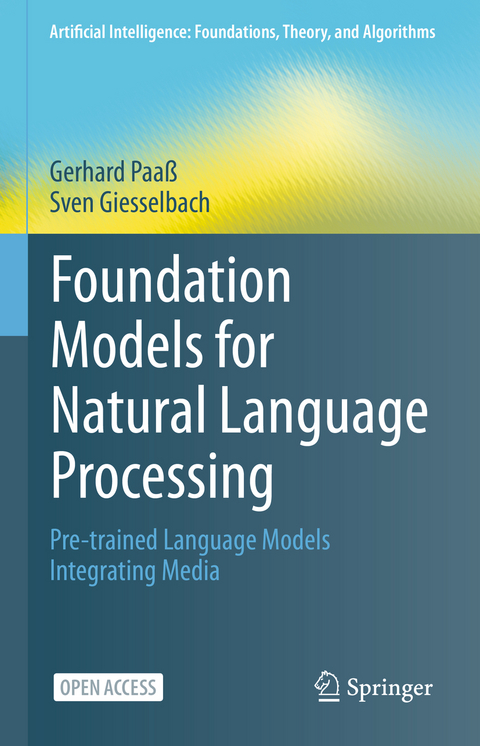
Foundation Models for Natural Language Processing
Springer International Publishing (Verlag)
978-3-031-23189-6 (ISBN)
This open access book provides a comprehensive overview of the state of the art in research and applications of Foundation Models and is intended for readers familiar with basic Natural Language Processing (NLP) concepts.
Over the recent years, a revolutionary new paradigm has been developed for training models for NLP. These models are first pre-trained on large collections of text documents to acquire general syntactic knowledge and semantic information. Then, they are fine-tuned for specific tasks, which they can often solve with superhuman accuracy. When the models are large enough, they can be instructed by prompts to solve new tasks without any fine-tuning. Moreover, they can be applied to a wide range of different media and problem domains, ranging from image and video processing to robot control learning. Because they provide a blueprint for solving many tasks in artificial intelligence, they have been called Foundation Models.
After a brief introduction to basic NLP models the main pre-trained language models BERT, GPT and sequence-to-sequence transformer are described, as well as the concepts of self-attention and context-sensitive embedding. Then, different approaches to improving these models are discussed, such as expanding the pre-training criteria, increasing the length of input texts, or including extra knowledge. An overview of the best-performing models for about twenty application areas is then presented, e.g., question answering, translation, story generation, dialog systems, generating images from text, etc. For each application area, the strengths and weaknesses of current models are discussed, and an outlook on further developments is given. In addition, links are provided to freely available program code. A concluding chapter summarizes the economic opportunities, mitigation of risks, and potential developments of AI.Dr. Gerhard Paaß is a Lead Scientist at the Fraunhofer Institute for Intelligent Analysis and Information Systems (IAIS). With a background in Mathematics, he is a recognized expert in the field of Artificial Intelligence, particularly in the area of Natural Language Processing. Dr. Paaß has previously worked at UC Berkeley in California and the University of Technology in Brisbane. He has served as reviewer and conference chair at various international conferences, including NeurIPS, CIKM, ECML/PKDD, ICDM, and KDD, where he regularly is a member of the program committee. Dr. Paaß has received a “best paper” award on probabilistic logic and is the author of about 70 publications for international conferences and journals. Recently, he authored the book “Artificial Intelligence: What's Behind the Technology of the Future?” (in German). He is currently involved in the creation of a computer center for Foundation Models. Besides experimental research on Foundation Models, he holds lectures for Deep Learning and Natural Language Understanding at the University of Bonn and in industry. Sven Giesselbach is the leader of the Natural Language Understanding (NLU) team at the Fraunhofer Institute for Intelligent Analysis and Information Systems (IAIS), where he has specialized in Artificial Intelligence and Natural Language Processing. He and his team develop solutions in the areas of medical, legal and general document understanding, which in their core build upon Foundation Models. Sven Giesselbach is also part of the Competence Center for Machine Learning Rhine-Ruhr (ML2R), where he works as a research scientist and investigates Informed Machine Learning, a paradigm in which knowledge is injected into machine learning models, in conjunction with language modeling. He has published more than 10 papers on Natural Language Processing and Understanding, which focus on the creation of application-ready NLU systems and the integration of expert knowledge in various stages of the solution design. He led the development of the Natural Language Understanding Showroom, a platform for showcasing state-of-the-art Natural Language Understanding models. He regularly gives talks about NLU at summer schools, conferences and AI-Meetups.
1. Introduction.- 2. Pre-trained Language Models.- 3. Improving Pre-trained Language Models.- 4. Knowledge Acquired by Foundation Models.- 5. Foundation Models for Information Extraction.- 6. Foundation Models for Text Generation.- 7. Foundation Models for Speech, Images, Videos, and Control.- 8. Summary and Outlook.
| Erscheinungsdatum | 26.05.2023 |
|---|---|
| Reihe/Serie | Artificial Intelligence: Foundations, Theory, and Algorithms |
| Zusatzinfo | XVIII, 436 p. 125 illus., 112 illus. in color. |
| Verlagsort | Cham |
| Sprache | englisch |
| Maße | 155 x 235 mm |
| Gewicht | 841 g |
| Themenwelt | Geisteswissenschaften ► Sprach- / Literaturwissenschaft ► Sprachwissenschaft |
| Informatik ► Theorie / Studium ► Künstliche Intelligenz / Robotik | |
| Schlagworte | Attention Models • Bert • Chatbot • Deep learning • Foundation Models • gpt • information extraction • Multilingual Models • Natural Language Generation • Natural Language Processing • Natural language understanding • open access • Pre-Trained Language Models • text generation • Transformer Models |
| ISBN-10 | 3-031-23189-9 / 3031231899 |
| ISBN-13 | 978-3-031-23189-6 / 9783031231896 |
| Zustand | Neuware |
| Informationen gemäß Produktsicherheitsverordnung (GPSR) | |
| Haben Sie eine Frage zum Produkt? |
aus dem Bereich


